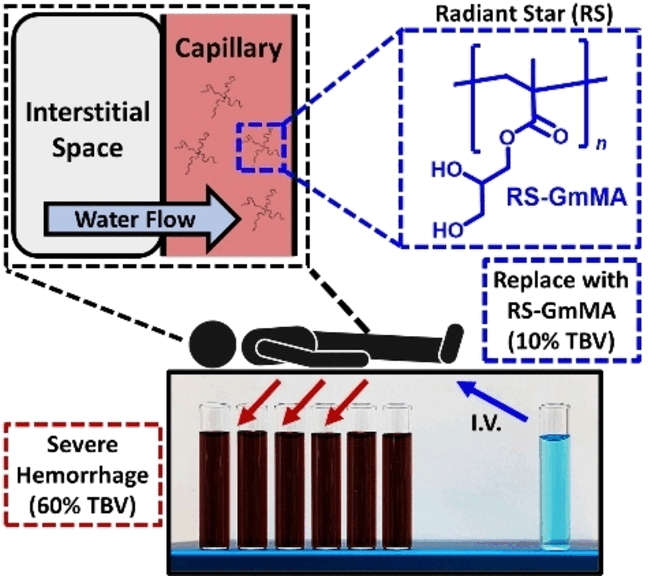Low volume resuscitant for prehospital treatment of severe hemorrhagic shock
Extensive blood loss after injuries is life-threatening and
must be counteracted as fast as possible. Relatively small volume
injections of solutions of a novel star-shaped polymer could compensate
for the loss of fluid without disrupting coagulation, reports a research
team in the journal Angewandte Chemie. This makes it particularly
interesting for preclinical treatment of hemorrhagic shock.

© Wiley-VCH, re-use with credit to 'Angewandte Chemie' and a link to the original article.
Traumatic injuries account for a large portion of morbidity
and death; in the USA, they are the primary cause of death in people
under 46 years of age. In cases of heavy blood loss, time is a critical
factor because shock can set in within minutes or hours after
injury—often before a patient reaches a clinic. Blood pressure
collapses, tissue no longer gets enough blood. The lack of oxygen forces
tissues into anaerobic respiration, inducing lactic acidosis. Cellular
sodium pumps shut down and water flows from the blood vessels into the
surrounding tissues. This further reduces blood volume and exacerbates
the state of shock. In addition, inflammatory reactions set in that
flood the tissue with toxic metabolites when blood flow later resumes,
possibly causing multiple organ failure.
The primary intervention used in such cases is replacement
of the lost fluid volume with substances such as saline solution. This
requires several liters of the liquid to be warmed to physiological
temperature—which is impractical outside of a clinic. The large volumes
administered also dilute clotting factors and raise blood pressure,
which can lead to further hemorrhage. For this reason, modern
resuscitation strategies (Damage Control Resuscitation, DCR) purposely
limit the administration of fluids and instead rely on whole blood
transfusions, which reduce clotting problems, inflammation, and the
mortality rate. In the field, in an ambulance or in a rescue helicopter,
this remains impracticable, particularly due to low supply.
The alternatives currently under development include
synthetic low-volume resuscitants (LVR), solutions that are highly
effective in small amounts, such as polyethylene glycol PEG20K. These
substances generate osmotic gradients that pull bodily fluids out of
tissues and back into the blood vessels. This reduces the volume
required for treatment and keeps blood pressure low. However, PEG20K
disrupts blood clotting and can cause allergic reactions.
A team led by Nathan J. White and Suzie H. Pun at the
University of Washington (Seattle, USA) has now developed a novel LVR.
By using a special, controlled polymerization process (RAFT), they were
able to synthesize many variations of methacrylate-based polymers with
different compositions, molecular weights, and properties. Among these,
a polymer shaped like a radiant star proved to be an effective LVR with
no negative effect on blood clotting.
After loss of about 60 % of blood volume in rat models, a
use of 10 % of this volume of the new polymer solution was able to
refill the blood vessels enough to return blood pressure to the desired
window and overcome shock. Even high doses of polymer produced no
observable adverse effects on blood clotting or organs, demonstrating
that the new radiant star polymer is an improvement over colloidal
resuscitants currently in development.
(3353 characters)
About the Author
Dr. Nathan White is an Associate Professor at the
University of Washington School of Medicine with appointments in
Emergency Medicine, Bioengineering, and Mechanical Engineering. His
primary research focuses on hemorrhage control and resuscitation
technologies, particularly in trauma with hemorrhagic shock. He serves
as the inaugural director of the Resuscitation Engineering Science Unit
(RESCU).
Suzie H. Pun is Washington Research Foundation Professor of Bioengineering at the University of Washington.
Copy
free of charge—we would appreciate a transcript/link of your article.
The original articles that our press releases are based on can be found
in our online pressroom.